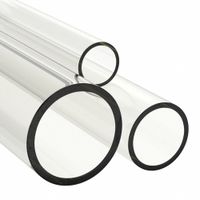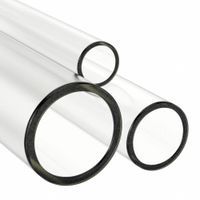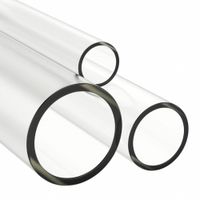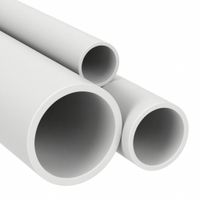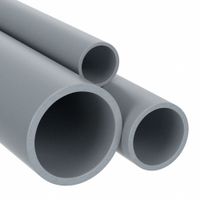Call +(254) 703 030 000 / 751 483 999 / 721 704 777
- Home
- Raw Materials
- Plastics
- Plastic Tubes
.....Read More
Frequently Asked Questions
What are the main uses of plastic tubes?
Plastic tubes are versatile components used across various industries due to their durability, flexibility, and cost-effectiveness. Here are the main uses:
1. **Medical Industry**: Plastic tubes are essential in medical applications for intravenous (IV) lines, catheters, and respiratory equipment. They are used for fluid transfer, drug delivery, and as conduits for medical gases.
2. **Construction**: In construction, plastic tubes are used for plumbing and drainage systems. They are preferred for their resistance to corrosion, ease of installation, and longevity.
3. **Agriculture**: Plastic tubing is used in irrigation systems to efficiently distribute water to crops. They are also used in greenhouses for climate control systems.
4. **Automotive Industry**: In vehicles, plastic tubes are used for fuel lines, brake systems, and air conditioning systems due to their ability to withstand high temperatures and pressures.
5. **Food and Beverage**: Plastic tubes are used in food processing and packaging for transporting liquids and semi-liquids. They are also used in beverage dispensers and as straws.
6. **Industrial Applications**: In manufacturing, plastic tubes are used for transporting chemicals, gases, and other materials. They are also used in pneumatic and hydraulic systems.
7. **Consumer Goods**: Plastic tubes are used in packaging for cosmetics, toiletries, and household products. They provide a lightweight and durable solution for product storage and dispensing.
8. **Electronics**: In electronics, plastic tubes are used for cable management and protection, ensuring safety and organization in wiring systems.
9. **Aerospace**: In aerospace, plastic tubes are used for fluid transfer systems and as insulation for wiring due to their lightweight and high-performance characteristics.
These applications highlight the adaptability and essential role of plastic tubes in modern industry and daily life.
How do acrylic tubes compare to glass tubes?
Acrylic tubes and glass tubes differ in several key aspects, including material properties, durability, weight, clarity, cost, and applications.
**Material Properties:** Acrylic, a type of plastic, is known for its flexibility and impact resistance. Glass, on the other hand, is more rigid and brittle, making it prone to shattering under stress.
**Durability:** Acrylic tubes are more durable than glass tubes due to their impact resistance. They are less likely to break or crack when dropped or subjected to force, making them suitable for environments where durability is crucial.
**Weight:** Acrylic is significantly lighter than glass, which makes acrylic tubes easier to handle, transport, and install. This lightweight nature is advantageous in applications where weight is a critical factor.
**Clarity:** Both acrylic and glass offer excellent clarity, but acrylic can sometimes provide better optical clarity and is less prone to yellowing over time. However, glass is more resistant to scratching, which can affect clarity in acrylic tubes.
**Cost:** Acrylic tubes are generally more cost-effective than glass tubes. The lower cost of production and material makes acrylic a popular choice for budget-conscious projects.
**Applications:** Acrylic tubes are widely used in applications where weight, impact resistance, and cost are important, such as in aquariums, displays, and certain industrial uses. Glass tubes are preferred in applications requiring high chemical resistance, thermal stability, and where scratch resistance is important, such as in laboratory settings and high-temperature environments.
In summary, the choice between acrylic and glass tubes depends on the specific requirements of the application, including factors like durability, weight, clarity, cost, and environmental conditions.
What are the advantages of UHMW polyethylene tubes?
UHMW polyethylene tubes offer several advantages:
1. **High Wear Resistance**: UHMW (Ultra-High Molecular Weight) polyethylene is known for its exceptional resistance to abrasion and wear, making it ideal for applications where durability is crucial.
2. **Low Friction**: These tubes have a low coefficient of friction, which reduces energy consumption and wear on moving parts, enhancing the efficiency and lifespan of machinery.
3. **Chemical Resistance**: UHMW polyethylene is resistant to a wide range of chemicals, including acids, alkalis, and organic solvents, making it suitable for use in harsh chemical environments.
4. **Impact Resistance**: The material can absorb significant impact without cracking or breaking, which is beneficial in applications where mechanical stress is a factor.
5. **Non-Stick Surface**: The non-stick properties prevent material build-up, which is advantageous in applications involving sticky or viscous substances.
6. **Lightweight**: Despite its strength and durability, UHMW polyethylene is lightweight, which can reduce transportation and installation costs.
7. **Corrosion Resistance**: It does not corrode, making it suitable for use in wet or corrosive environments.
8. **Temperature Tolerance**: UHMW polyethylene can perform well in a wide temperature range, maintaining its properties in both low and moderately high temperatures.
9. **Noise Reduction**: The material can dampen noise and vibrations, which is beneficial in reducing noise pollution in industrial settings.
10. **FDA Compliance**: Many UHMW polyethylene products are FDA compliant, making them suitable for use in food processing and pharmaceutical applications.
11. **Easy Machinability**: It can be easily machined into complex shapes, allowing for customization in various applications.
These advantages make UHMW polyethylene tubes a versatile choice for industries such as food processing, automotive, chemical processing, and material handling.
What are the properties of PVC tubes?
PVC (Polyvinyl Chloride) tubes are widely used in various applications due to their versatile properties. Here are the key properties:
1. **Durability**: PVC tubes are highly durable and resistant to wear and tear, making them suitable for long-term use in various environments.
2. **Corrosion Resistance**: They are resistant to corrosion from chemicals, acids, and salts, which makes them ideal for plumbing and industrial applications.
3. **Lightweight**: PVC tubes are lighter than metal pipes, which makes them easier to handle, transport, and install.
4. **Cost-Effective**: They are generally more affordable than metal pipes, offering a cost-effective solution for many applications.
5. **Thermal Resistance**: PVC tubes have good thermal resistance, although they are not suitable for high-temperature applications. They can withstand temperatures up to about 60°C (140°F).
6. **Electrical Insulation**: PVC is a good insulator, making PVC tubes suitable for electrical conduit applications.
7. **Flexibility**: While rigid, PVC tubes can be made flexible with the addition of plasticizers, allowing for a range of applications.
8. **Low Maintenance**: They require minimal maintenance due to their resistance to corrosion and chemical degradation.
9. **Smooth Surface**: The smooth interior surface of PVC tubes reduces friction and allows for efficient fluid flow.
10. **Non-Toxic**: When used in potable water systems, PVC tubes are safe and do not leach harmful chemicals.
11. **Fire Resistance**: PVC is inherently flame-retardant due to its chlorine content, which helps in reducing fire hazards.
12. **Recyclability**: PVC tubes can be recycled, contributing to environmental sustainability.
These properties make PVC tubes a popular choice in construction, plumbing, electrical, and industrial applications.
How do polycarbonate tubes resist impacts?
Polycarbonate tubes resist impacts due to their unique molecular structure and inherent material properties. Polycarbonate is a thermoplastic polymer known for its high impact resistance, which is significantly higher than that of many other plastics, such as acrylic. This resilience is primarily due to the presence of carbonate groups within the polymer chain, which provide flexibility and toughness.
The molecular structure of polycarbonate consists of long chains of repeating units that can absorb and dissipate energy when subjected to impact. This energy absorption is facilitated by the ability of the polymer chains to deform without breaking, allowing the material to withstand significant force without shattering. The flexibility of the chains enables them to bend and stretch, distributing the impact energy over a larger area and reducing the likelihood of fracture.
Additionally, polycarbonate has a high degree of transparency and optical clarity, which does not compromise its impact resistance. The material's amorphous nature, meaning it lacks a crystalline structure, contributes to its toughness, as it allows for more uniform stress distribution throughout the material.
Polycarbonate's impact resistance is further enhanced by its ability to maintain structural integrity across a wide temperature range. It remains ductile and does not become brittle in cold conditions, which is a common issue with other plastics. This property ensures that polycarbonate tubes can perform reliably in various environmental conditions.
Overall, the combination of a flexible molecular structure, energy absorption capabilities, and temperature resilience makes polycarbonate tubes exceptionally resistant to impacts, making them suitable for applications where durability and safety are paramount.
What are the differences between acrylic and polycarbonate tubes?
Acrylic and polycarbonate tubes are both popular thermoplastics used in various applications, but they have distinct differences:
1. **Material Composition**:
- **Acrylic**: Made from polymethyl methacrylate (PMMA), acrylic is known for its clarity and aesthetic appeal.
- **Polycarbonate**: Composed of bisphenol A and phosgene, polycarbonate is recognized for its strength and impact resistance.
2. **Clarity and Appearance**:
- **Acrylic**: Offers superior optical clarity and is often used where transparency is crucial. It is more resistant to yellowing over time.
- **Polycarbonate**: While also clear, it may have a slight tint and can yellow with prolonged UV exposure.
3. **Strength and Durability**:
- **Acrylic**: Less impact-resistant than polycarbonate, it can crack or shatter under high stress.
- **Polycarbonate**: Extremely tough and virtually unbreakable, making it ideal for high-impact applications.
4. **Weight**:
- Both materials are lightweight, but polycarbonate is slightly heavier than acrylic.
5. **Temperature Resistance**:
- **Acrylic**: Can withstand temperatures up to 160°F (71°C) before deforming.
- **Polycarbonate**: Can endure higher temperatures, up to 240°F (116°C), without losing structural integrity.
6. **Cost**:
- **Acrylic**: Generally more affordable, making it a cost-effective option for many projects.
- **Polycarbonate**: More expensive due to its enhanced durability and impact resistance.
7. **Machinability**:
- **Acrylic**: Easier to cut, shape, and polish, offering a smooth finish.
- **Polycarbonate**: More challenging to machine due to its toughness, but it can be drilled and cut without cracking.
8. **Applications**:
- **Acrylic**: Used in displays, aquariums, and decorative items.
- **Polycarbonate**: Preferred for safety glasses, bulletproof windows, and protective barriers.
How do you choose the right type of plastic tube for a specific application?
To choose the right type of plastic tube for a specific application, consider the following factors:
1. **Material Compatibility**: Ensure the plastic material is compatible with the substances it will contact. For example, PVC is suitable for water, while PTFE is better for chemicals.
2. **Temperature Resistance**: Select a plastic that can withstand the operating temperature range. Polypropylene is good for moderate temperatures, while PEEK can handle high temperatures.
3. **Pressure Requirements**: Determine the pressure the tube must withstand. Polyurethane is suitable for high-pressure applications, whereas LDPE is better for low-pressure uses.
4. **Flexibility and Rigidity**: Decide if the application requires a flexible or rigid tube. Silicone offers high flexibility, while ABS provides rigidity.
5. **Durability and Longevity**: Consider the tube's resistance to wear, UV exposure, and environmental conditions. HDPE is durable for outdoor use, while Nylon is abrasion-resistant.
6. **Size and Dimensions**: Ensure the tube's inner and outer diameters fit the application requirements, considering flow rate and space constraints.
7. **Regulatory Compliance**: Check for compliance with industry standards and regulations, such as FDA approval for food and medical applications.
8. **Cost and Availability**: Balance the cost with performance needs. Some materials like PTFE are more expensive but offer superior chemical resistance.
9. **Aesthetic and Transparency Needs**: For applications requiring visibility of the contents, opt for clear materials like polycarbonate.
10. **Installation and Maintenance**: Consider ease of installation and maintenance. Flexible tubes are easier to install in tight spaces.
By evaluating these factors, you can select a plastic tube that meets the specific demands of your application, ensuring safety, efficiency, and cost-effectiveness.

